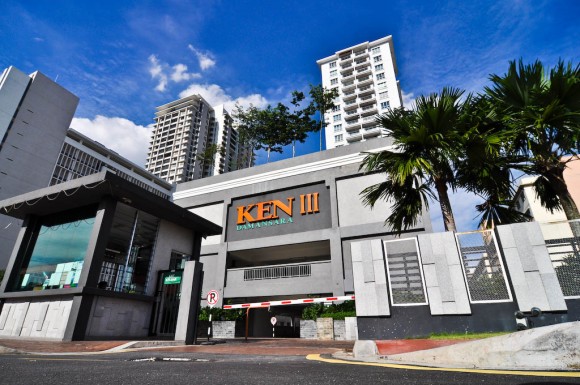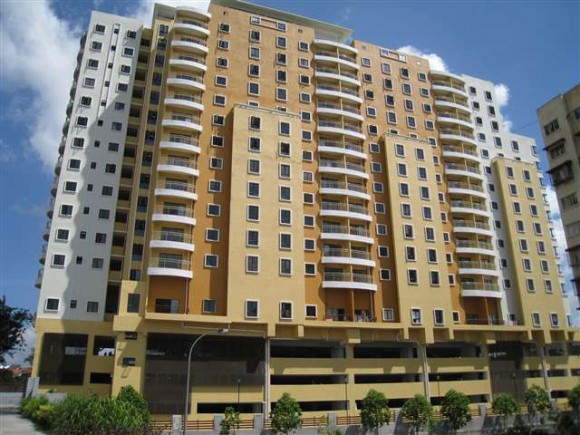ONE of my investigations as a Petaling Jaya City Council (MBPJ) councillor has been into the mystery of how the council could allow a 24-storey building to go up when the project only had a planning permission for 22 storeys.
I usually begin any investigation by requesting information through official means. Since councillors don’t always get an official written reply, I have had to find other means of getting the information I want. So, to answer the question of how Ken Damansara 3 became a 24-storey building, I tried to get my hand on the MBPJ’s development rules. But instead of finding an answer, I discovered a lot more questions.

MBPJ’s rules
Here’s what I found. The MBPJ guidelines, approved on 29 July 1995, states, among others, the following requirements for condominiums/apartments:
![]() Building height: Not more than 20 floors
Building height: Not more than 20 floors
![]() Public facilities:
Public facilities:
![]() Surau
Surau
![]() Kindergarten
Kindergarten
![]() Neighbourhood shops
Neighbourhood shops
![]() Games court
Games court
![]() Children’s playground
Children’s playground
![]() Community hall
Community hall
There are other requirements. But these three requirements alone already call into question most of the MBPJ-approved high-rise developments that have gone up. Many buildings approved by MBPJ of late, for example Ken Damansara 3, are above 20 floors in height. Others do not have all the facilities mentioned in the council guidelines. And projects like Paramount View are even built on land smaller than two acres.

Federal standards
Now let’s look at the federal government’s High-rise Housing Development Standards, which are a whole lot more stringent in their requirements than the MBPJ’s. The points are applicable across the board for high-rise residential buildings:
![]() A minimum lot size is 0.8 hectares (two acres) [Rule 5(ii), p.9]
A minimum lot size is 0.8 hectares (two acres) [Rule 5(ii), p.9]
![]() A minimum football field-sized open space or 10% of the land area, whichever is bigger [Rule 5(xv), p.11]
A minimum football field-sized open space or 10% of the land area, whichever is bigger [Rule 5(xv), p.11]
![]() The main entrance/exit road must be at least 20m wide [Rule 7(i)e, p.33]
The main entrance/exit road must be at least 20m wide [Rule 7(i)e, p.33]
![]() There must be a secondary exit [Rule 5(xii), p.11 and Rule 6.5(vi), p.27]
There must be a secondary exit [Rule 5(xii), p.11 and Rule 6.5(vi), p.27]
![]() Development schemes with more than 30 residential units must prepare a central sewerage treatment system [Rule 6.6(iii), p.28]
Development schemes with more than 30 residential units must prepare a central sewerage treatment system [Rule 6.6(iii), p.28]
Federal standards should overrule local council standards. Section 58 of the Town and Country Planning Act allows either the state or federal government to make rules for car parks, open spaces, density control and others. There is no mention in the Act of the local council being allowed to make these rules. The local council is therefore required to adopt rather than make these rules themselves, which curiously does not seem to be the case with MPBJ.
Non-adherence consequences
These standards were not plucked out of thin air. Each requirement was thought out and formulated to prevent some of the current problems plaguing high-rise properties.

For example, the need for a sewerage treatment plant to be built for high-rise buildings is to prevent problems like overflowing sewage, which the residents of PJS 1 are now facing. The area has plenty of high-rise buildings, but an insufficient number of sewage treatment plants (for the specifics on the ratio of sewage treatment plants to the population density, read this).
Meanwhile, the 20m-wide entrance requirement gives adequate access to fire engines in the event of an emergency. It also prevents traffic congestion in an area by ensuring cars are not slowed down by a narrow entrance.
Having a secondary exit, aside from easing traffic issues, also helps in the event that one of the exits is blocked off for whatever reason.
These are just some highlights of the federal requirements. There are many others that developers will actually find difficult to comply with, like the limitation on a building’s height based on the neighbouring building’s height (Rule 7.1.4, p.30). Basically, this rule would prevent a tall building from being built next to a house, as the taller the building is, the greater the distance the building must be from the house.
People’s rights
I am unable to ascertain whether these are the standards that MBPJ still uses because the council prefers to be silent despite my inquiries about the 24-storey Ken Damansara 3.
That aside, residents who live near empty plots of land that have been earmarked for development should familiarise themselves with these guidelines. Knowing and understanding the guidelines will help the public gauge what is fair and approved practice instead of relying on a council or government officer’s word.
Residents should also demand for layout plans and other related documentation so they can scrutinise the details of any proposed project and make their own assessment. After all, the public has a right to keep their government in check. And that includes local governments, which, while not elected, have the most impact on people’s daily lives. ![]()
MBPJ councillor KW Mak’s favourite advice to residents is: “Do not trust anyone, not even me. Trust what you see with your own eyes. If someone says something is legal, ask them to show you the documentation that proves it is legal.”


Peter Leow says
The chief secretary directed that all civil servants MUST respond to ALL questions asked by the public. If you cannot get any response, please consider writing to the director general of the Public Complaints Bureau Datuk Dr Tam Weng Wah. I always get his speedy response. You should write to him directly too. Thank you.
tixiti says
Please watch out. The developers will be coming after you!
KW Mak says
@ tixiti
Is that a threat or advice?
Regardless, my response is this: I will not live my life bound by fear of what might happen. I took an oath to serve the public, and that is what I will do. In the end, we will all meet our Maker. I’d rather meet the Almighty saying that I tried my best.
Regards.